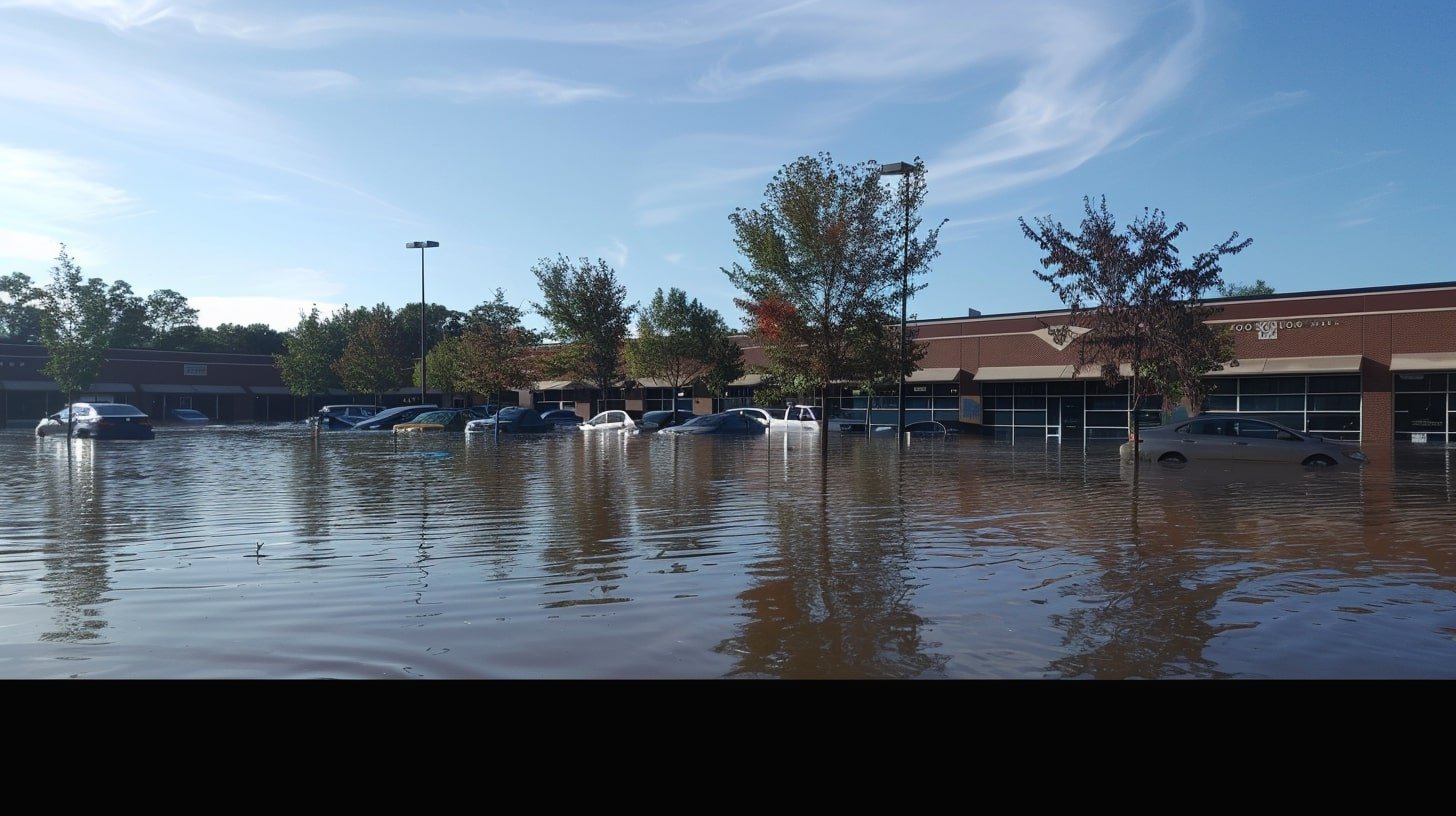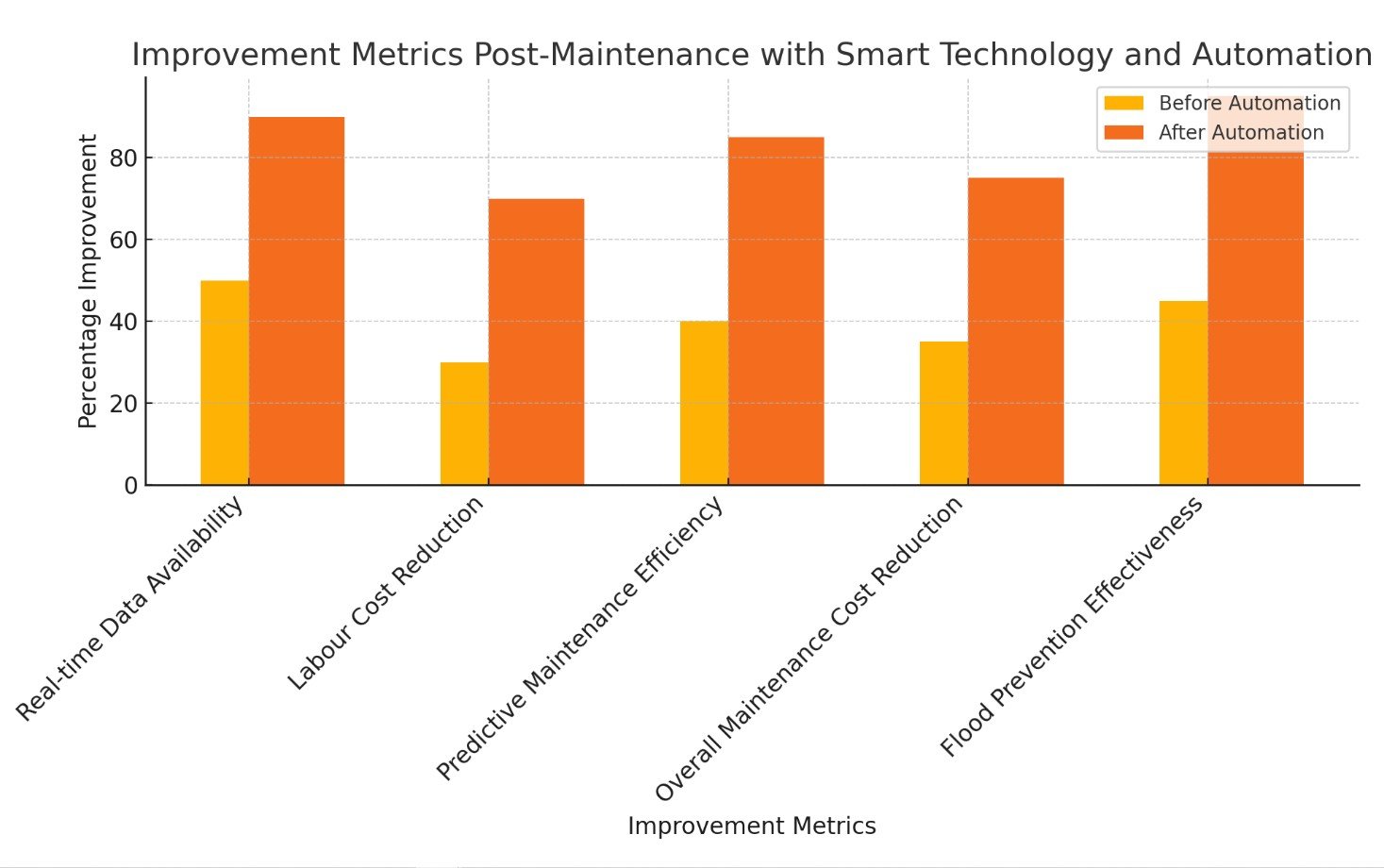Maintaining a parking lot is no small feat, especially when it comes to managing stormwater. Effective storm drain maintenance is crucial to prevent the costly and damaging effects of parking lot flooding. When storm drains fail, water can accumulate rapidly, leading to hazardous conditions, damage to asphalt and structures, and potential legal liabilities. This article explores why regular maintenance of storm drains is not just a necessity but an essential practice for property managers and owners alike.
Table of Contents
Why Maintenance Matters
Proper maintenance of storm drains ensures that they function optimally, particularly during severe weather conditions. Without regular checks and cleaning, drains can become clogged with debris, resulting in overflow and flooding. Moreover, well-maintained storm drains extend the lifespan of the parking surface by preventing water accumulation and the associated erosive effects.
Consequences of Neglect
Neglecting storm drain maintenance can lead to significant financial costs and safety risks. Water pooled in parking areas can seep into the subsurface, undermining the structural integrity of the pavement and leading to costly repairs. Additionally, standing water poses slip and fall hazards, putting both pedestrians and vehicles at risk, which could potentially lead to legal actions against property owners.
Key Takeaway: Preventative maintenance not only saves money in the long run but also ensures safety and compliance with local stormwater management regulations.
Understanding the Basics of Storm Drains
Storm drains play a pivotal role in urban infrastructure by managing rainwater and meltwater to prevent flooding of roads and properties such as parking lots. These systems are designed to channel water away from built-up areas toward natural reservoirs or municipal drainage systems. Understanding their function and types is critical in effective parking lot management.
How Storm Drains Work
A typical storm drain system consists of a surface grate, a catch basin to trap sediments and larger debris, pipes that transport water, and an outlet that discharges into a body of water or a sewer. These components work together to ensure rapid removal of water from surfaces to minimize flooding risks.
Effectiveness depends on several factors including:
- Proper installation and positioning relative to the lowest points in the parking lot,
- Regular maintenance to keep the grates and pipes clear of obstructions,
- Adequate sizing of pipes and outlets to handle peak flow volumes during heavy rainfalls.
Types of Storm Drains in Parking Lots
Storm drains in parking lots vary based on construction and design tailored to specific needs:
- Linear Drains: Long, narrow grates that catch water over a wide area, ideal for large, flat expanses.
- Point Drains: Positioned at low points to catch water pooling from nearby areas.
- French Drains: Subsurface systems that intercept subsoil water movements and channel them away.
Understanding these types helps in selecting the appropriate system for a particular parking lot configuration and expected water flow.
Common Causes of Storm Drain Blockage
Blockages are a primary concern in storm drain maintenance. They can drastically reduce the efficiency of water management systems and lead to considerable flooding. Identifying common causes of blockage can help in formulating effective preventive strategies.
Natural Debris Accumulation
Leaves, twigs, and organic matter can accumulate especially during fall and spring. They easily get washed into grates leading to clogs. Regularly clearing the surrounding landscape and installing guards can mitigate this issue.
Human-generated Waste
Litter, plastic bags, and other trash discarded improperly often end up in storm drains. This not only obstructs water flow but also contaminates water bodies where the drains discharge. Enforcing stringent waste disposal policies and public awareness campaigns are essential measures.
Structural Failures
Aged infrastructure and poor construction can lead to broken pipes and collapsed grates, further exacerbating flooding issues. Regular inspections and timely replacement or repair of damaged components are crucial to maintain the functionality of storm drains.
Fun Fact: Did you know that a single plastic bag can travel more than 1,800 miles inside a storm drain system before reaching an ocean?
Regular Maintenance Techniques
To ensure the functionality of parking lot storm drains, a consistent and effective maintenance plan must be in place. This includes routine inspections, cleaning, and immediate repair of any damage.
Inspection and Assessment Procedures
Regular inspections are the first step in preventive maintenance. This involves:
- Checking for visible signs of blockage and wear,
- Inspecting the integrity of grates and catch basins,
- Assessing the flow rate during and after rainfalls to gauge any underperformance.
A simple checklist can help ensure that no element of the system is overlooked during inspections.
| Category | Procedure | Status |
|---|---|---|
| Visual Inspection | Check for visible blockages at the surface grates. | [ ] |
| Inspect the catch basins for accumulated debris. | [ ] | |
| Look for standing water around the drains. | [ ] | |
| Examine the condition of the grates for any signs of damage or wear. | [ ] | |
| Assess the pavement around the drains for signs of erosion or cracks. | [ ] | |
| Functional Testing | Pour a bucket of water into the drain to check for proper flow. | [ ] |
| Observe how quickly the water is drained. | [ ] | |
| Note any slow drainage or water backing up. | [ ] | |
| Subsurface Inspection | Use a flashlight to inspect inside the catch basin for blockages or debris. | [ ] |
| Check the condition of the drain pipes if visible. | [ ] | |
| Identify any structural damage to the pipes or catch basins. | [ ] | |
| Technological Assessment | Utilize an infrared camera to detect thermal variations indicating blockages. | [ ] |
| Deploy ground-penetrating radar (GPR) to identify subsurface anomalies. | [ ] | |
| Record and analyze data from sensors if a smart drainage system is in place. | [ ] | |
| Surrounding Area Inspection | Inspect the surrounding landscape for potential sources of debris. | [ ] |
| Check for signs of water pooling or erosion near the drains. | [ ] | |
| Ensure that nearby vegetation does not obstruct the drainage path. | [ ] | |
| Documentation and Reporting | Take photographs of any issues found. | [ ] |
| Record the location and description of each problem area. | [ ] | |
| Create a detailed report of findings, including recommended actions. | [ ] | |
| Schedule follow-up inspections or maintenance based on the severity of the issues. | [ ] | |
| Safety Measures | Wear appropriate personal protective equipment (PPE), including gloves, safety glasses, and boots. | [ ] |
| Set up safety cones and warning signs around the inspection area. | [ ] | |
| Ensure all tools and equipment are in good working condition. | [ ] | |
| Post-Inspection Review | Discuss findings with the maintenance team or property management. | [ ] |
| Prioritize repairs and cleaning based on the urgency of the issues identified. | [ ] | |
| Develop an action plan and timeline for addressing any problems. | [ ] | |
| Preventative Measures | Schedule regular maintenance checks and cleanings. | [ ] |
| Implement debris guards or filters if necessary. | [ ] | |
| Plan for seasonal maintenance activities, particularly before heavy rain or snow seasons. | [ ] |
Cleaning and Clearing Drains
Removing debris and sediments regularly is imperative to prevent blockages. Techniques include:
- Manual removal of large debris,
- Using hydro-jetting for comprehensive cleaning,
- Implementing sediment traps to ease maintenance.
In addition, employing environmentally friendly cleaning agents helps in maintaining the ecological balance.
Identifying and Addressing Damage
Spotting early signs of damage can prevent costly repairs down the line. Key aspects include checking for cracks, misalignment of pipes, and ineffective seals around manholes and grates. Regularly scheduled professional inspections can help spot these issues before they aggravate.
Key Takeaway: Prevention is better than cure, especially when it involves infrastructure that prevents flooding.
Preventive Measures to Avoid Flooding
Prevention is always better than reactive measures when dealing with parking lot flooding. This section explores various strategies property owners can take to minimize the risk of storm drain blockage and consequent flooding.
Installing Drain Guard Solutions
Drain guards are effective tools for catching debris before it enters the storm drain system. Options like catch basin filters and mesh screens can significantly reduce the amount of debris accumulation. It’s vital to select guards that are appropriate for the expected types of debris and weather conditions specific to the area.
Landscaping to Facilitate Drainage
Landscaping is not just about aesthetics; strategically placed vegetation can greatly enhance drainage and prevent water accumulation. Consider:
- Planting grass and shrubs in areas prone to erosion,
- Using permeable pavement options which allow water to soak through and reduce runoff,
- Creating rain gardens to naturally catch and filter stormwater.
Regular Pavement Maintenance
Maintaining the pavement integrity is crucial in preventing water pooling. Regular resurfacing and sealing cracks prevent water from seeping underneath, which can lead to structural weaknesses. Also, ensuring that pavement slopes direct water toward drains rather than allowing it to collect can form part of a proactive strategy against flooding.
When to Call Professionals
While routine maintenance can often be handled internally, there are situations when it’s prudent to call in professional help. Knowing when to bring in experts can save time and prevent minor issues from becoming large-scale problems.
Signs You Need Expert Help
Some signs that professional assistance is needed include:
- Severe drain blockages that basic techniques cannot clear,
- Structural damage to the drainage system,
- Recurrent flooding despite regular maintenance.
Choosing the Right Maintenance Service
Selecting the right professionals involves several considerations to ensure quality service:
- Look for companies with specific experience in storm drain maintenance,
- Check for localized knowledge, notably in handling regional environmental conditions,
- Assess reviews and references for a track record of reliability and effectiveness.
| Criteria | Edenflo Pump Truck Services | R&B Plumbing and Heating | City Wide Environmental Cleaning |
|---|---|---|---|
| Experience and Reputation | Over 30 years in the industry, strong reputation | Established firm with a wide range of services | Over 30 years in business, highly reputable |
| Services Offered | Comprehensive storm drain and catch basin cleaning, video line inspection, hydro flushing | General drain cleaning, video inspections, sewer repairs | Complete storm drain maintenance, video inspections, hydro flushing, catch basin cleaning (https://citywidebc.ca/services/) |
| Certifications and Licenses | Fully certified and licensed | Certified, specialized in plumbing and heating | Fully certified and licensed |
| Pricing | Moderate pricing with premium services | Competitive pricing | Competitive, value-driven pricing |
| Response Time | Quick response, 24/7 emergency service | Standard business hours, some after-hours service | 24/7 emergency service, quick response |
| Warranty and Guarantees | Service warranties offered | Limited warranties | Comprehensive warranties on all services |
| Technology Used | Advanced tech including GPR and infrared inspections | Basic and some advanced diagnostic tools | Latest technology including smart systems |
| Environmental Practices | Eco-friendly practices, sustainable materials | Standard practices | Strong emphasis on sustainability and green practices |
| Customer Service | Excellent support, dedicated account managers | Standard customer service | Top-rated customer service, dedicated support |
| Coverage Area | Extensive coverage in Vancouver and surrounding areas | Local area coverage | Extensive coverage across Vancouver and BC |
| References and Reviews | Strong positive reviews, multiple references available | Mixed reviews | Excellent reviews, numerous references |
Legal and Regulatory Considerations
Compliance with local laws and regulations is critical when managing storm drains in parking lots. This section reviews some of the key legal standards and practices to help property managers avoid legal pitfalls.
Compliance with Local Laws
Every municipality has specific ordinances and standards governing stormwater management. These might include regulations on:
- Water quality standards,
- Stormwater facility maintenance,
- Documentation and reporting of maintenance activities.
Understanding and adhering to these laws not only ensures compliance but also promotes responsible environmental stewardship.
Ensuring Accessibility and Safety
The configuration of storm drains must also consider accessibility standards, such as those set forth by the ADA (Americans with Disabilities Act) or relevant local analogues. This includes ensuring that grates do not impede the movement of people with disabilities and that all areas remain safe and accessible even during adverse weather conditions.
Key Takeaway: Legal foresight is not only about compliance but also about anticipating future requirements and maintaining a proactive stance in stormwater management.
Long-term Improvements and Upgrades
Incorporating advanced solutions and continuous improvements in storm drain systems ensures sustainable management of parking lot flood risks. Long-term strategies go beyond routine maintenance, focusing on enhanced efficiency and future-proofing investments.
Advanced Drainage Systems
Advancements in drainage technology offer significant improvements over traditional methods:
- Smart Drain Systems: These utilise sensors to monitor flow rates and detect blockages automatically, alerting maintenance teams proactively.
- Water-Sensitive Urban Design (WSUD) Features: Integrating features like bio retention systems and swales that not only manage runoff but also improve water quality.
- Modular Wetlands: Act as both a filter and a conduit, enhancing the aesthetics while providing effective water management.
Investing in such technologies not only enhances the efficiency of stormwater management but also contributes to environmental sustainability.
Smart Technology and Automation in Storm Drain Management
Automation in storm drain management is becoming increasingly prevalent, offering the following benefits:
- Real-time Data: Automated systems provide real-time updates on storm drain conditions, allowing for immediate responses.
- Reduced Labour Costs: Automation can decrease the need for manual inspections and cleanings, reducing overall maintenance costs.
- Enhanced Predictive Maintenance: With data analytics, predictive maintenance can be conducted, addressing potential issues before they lead to system failures.
Embracing these technological solutions not only secures the property against future flooding but also aligns with modern, efficient property management practices.
DIY vs. Professional Maintenance
Understanding the balance between DIY maintenance tasks and when to call in professionals, like City Wide, can lead to more effective management and cost savings.
What Can You Handle Yourself?
Simple tasks like regular inspections and clearing of debris can often be managed in-house:
- Using basic tools to remove visible trash and debris,
- Regularly updating checklists and schedules to ensure consistency in maintenance efforts,
- Training staff on identifying early signs of drain issues.
When to Invest in Professional Services
More complex issues require professional intervention. Criteria for enlisting expert help include:
- Severe structural issues that pose safety risks,
- Technological upgrades like installing smart drainage systems,
- Compliance audits and reviews by regulatory bodies.
Professional services ensure that complex tasks are handled with expertise, leaving little room for error and securing the property’s safety and compliance.
Conclusion
Effective storm drain maintenance is critical for preventing parking lot flooding, a problem that can lead to significant property damage, safety hazards, and financial loss. Through this article, we’ve explored a myriad of strategies—from basic maintenance routines to advanced technological interventions—that can help manage and mitigate these risks. We’ve also delved into how a blend of DIY efforts and professional expertise can formulate a preventive rather than reactive approach, ensuring a well-maintained parking area ready to withstand weather challenges.
Remember, the key to successful storm drain management lies in regular maintenance, timely inspections, and staying informed about the latest improvements and legal requirements. Equipping yourself with the right knowledge and resources, as outlined here, will empower you to protect your property effectively, enhance its value, and contribute positively to the environment. Whether you decide to handle maintenance internally or enlist professional help, understanding the critical role of effective storm drainage and committing to its upkeep is essential for long-term success and safety.
Preventative measures and a proactive approach will not only save you costly repairs but will also ensure that your parking facilities continue to operate smoothly, safely, and efficiently, no matter what the weather brings.
FAQs
- What is the best season to conduct storm drain maintenance?
Ideal maintenance timing can vary based on climatic conditions, but generally, it’s prudent to schedule inspections and cleanings before the onset of heavy rainy seasons or snowfall, which are typically spring and autumn in most regions. - How often should storm drain inspections be conducted?
Inspections should ideally be conducted at least biannually. However, areas prone to higher debris accumulation or those that experience frequent severe weather might require more frequent checks. - Can landscaping really impact drainage effectiveness?
Absolutely. Thoughtful landscaping can significantly improve water management by facilitating better absorption and runoff redirection, ultimately reducing the burden on storm drains. - What are the typical costs involved in maintaining a parking lot storm drain?
Costs can vary widely depending on the size of the parking lot, the condition of existing drainage facilities, and local labour rates. Preventative maintenance is typically less costly than emergency interventions post-flooding. - Are there any eco-friendly options for storm drain maintenance?
Yes, options include using sediments and debris filters that are recyclable and employing non-toxic cleaning agents for clearing drains. Installing green infrastructure like permeable pavements and rain gardens also supports sustainability.










